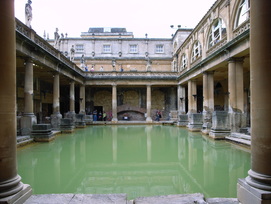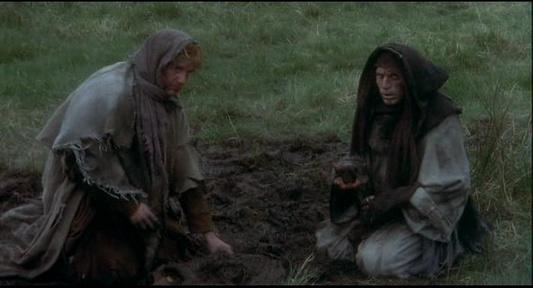 The Tin Man stuck in one position because he needed oil
The Tin Man stuck in one position because he needed oil With very little understanding of the connection between dirt and germs, cleanliness was not a priority of homes in the middle ages. However, one thing that everybody understood was the need to keep the armor clean. The knight was the "do all" defender of the castle and a knight in rusty armor was no defense at all. Think of the Tin Man from the Wizard of Oz. Unable to oil his joints he rusted into immobility. So it would be for a knight if his armor was not carefully cleaned, oiled and polished. The preferred potion for cleaning plate armor was a mixture of sand, vinegar and urine (the all purpose fluid of the middle ages). Here is a a fascinating demonstration of just how dirty a knight would be at the end of an average day of stabbing, slicing, hammering, and battering.
 The Great Bath at Bath, England
The Great Bath at Bath, England The Romans who occupied Britain for almost 500 years brought with them the lightweight clothing of warmer climates, central heating for their houses, and baths for everyone. So great was their love of bathing, that a city in England still bears the name of Bath. If we place King Arthur among the last Romans left in Britain, or if we place him just a little later in history, then he and his court were people who liked to keep themselves clean. A post-Roman Camelot may well have been a sweet smelling place with baths and laundry maids and clean clothes for all .
 Unwashed Medieval peasants, courtesy of Monty Python
Unwashed Medieval peasants, courtesy of Monty Python However, as the memory of the Roman occupation faded, so did the memory of hot baths. Within two hundred years of the departure of the Roman legions, the people of Britain under the leading of the church, began to believe that bathing was not only dangerous, but sinful. The church declared public bathhouses to be immoral, and banned bathing naked even in one's own home. With the loss of public bathhouses, the lower classes lost any desire to bathe. They had been told that bathing was dangerous, that water opened the pores and allowed diseases to be admitted. Nobles and barons began to restrict access to forests and peasants had no way to obtain firewood to heat bathwater. Most of the lower classes, especially men, were reduced their bathing to no more than once a year, and even reduced the amount of "spot cleaning." It was considered unhealthy to wash the entire face as this could lead to poor eyesight.
 Louise XIV, the Sun King who never bathed
Louise XIV, the Sun King who never bathed Even the nobility restricted their bathing. This restriction persisted for centuries. In 1638 the Russian Ambassador to France reported that King Louis XIV, the Sun King, stank like a wild animal. Louis himself admitted that he had only bathed twice in his entire life. Considering that Louis reigned for 72 years, this is a long time to go without a bath.
Queen Isobel of Spain (1451-1504) was proud of the fact that she had also only bathed twice, once when she was born and once more when she was married.
Queen Isobel of Spain (1451-1504) was proud of the fact that she had also only bathed twice, once when she was born and once more when she was married.
 Queen Elizabeth I, holding a pomander
Queen Elizabeth I, holding a pomander When the Romans left, they were replaced by waves of invaders from Europe. The Saxons came from what is now Germany, and Vikings invaded from Scandinavia. These were northern people dressed in heavy furs and woolen tunics. The light washable garments of the Romans were replaced by heavy fabrics, hard to wash and impossible to dry in England's damp climate. Yes, laundry maids existed, and yes, linen underclothing and shirts could be washed, but the heavy woolen outer garments rarely received such attention. Important items of clothing were hung in the latrine or privy, where the stench would keep away moths. On special occasions, when the nobility gathered together with their unwashed bodies, and their clothes that stank of the latrine, the normal defense was to carry scented cloths, or to pin pomanders to the clothing. It is hard to imagine that the addition of additional odors would have solved the problem.
 Pomander to ward off the stench of Medieval wedding guests
Pomander to ward off the stench of Medieval wedding guests The cute flower girls we see at weddings today, are a throwback to the time when only a pomander or a bouquet of flowers could overcome the stench of wedding guests, and perhaps the stench of the bridegroom.
And now for the most important question of all. Is it possible to be too clean? Do Americans take too many showers?
It is only in the last 100 years that it has even been possible for the average American to take a daily bath or shower. For most of the 19th and early 20th century weekly baths were the norm. (Usually on Saturday nights)
And now for the most important question of all. Is it possible to be too clean? Do Americans take too many showers?
It is only in the last 100 years that it has even been possible for the average American to take a daily bath or shower. For most of the 19th and early 20th century weekly baths were the norm. (Usually on Saturday nights)
 You mean showers are bad for me?
You mean showers are bad for me? Certainly Americans take more showers and use more soap than Europeans but that is not to say that their hair and skin are any more healthy than the hair and skin of Europeans. The average American use 17 gallons of water for an eight minute shower and most Americans wash their bodies with soap and their hair with shampoo every day. Strangely enough, a chemically clean body is not necessarily a healthy body. The frequent use of hot water and soaps strips the skin of its natural oils and and not only creates dry skin, but also exposes the skin to harmful bacteria. (There was a kernel of truth in the medieval superstition against too much washing) Additionally, any chemical residue left on the skin after rinsing can be absorbed into the bloodstream. Alternating the occasional hot shower with brief lukewarm showers and minimal use of soap, will allow the skin to regain its natural balance and its place as a barrier to infection. Hair that is subjected to hot water, shampoos, and blow dryers every day will also benefit from only being washed every other day. This is just something to think about as our rivers and streams struggle to cope with a daily influx of chemicals from soaps, shampoos and detergents.
 RSS Feed
RSS Feed